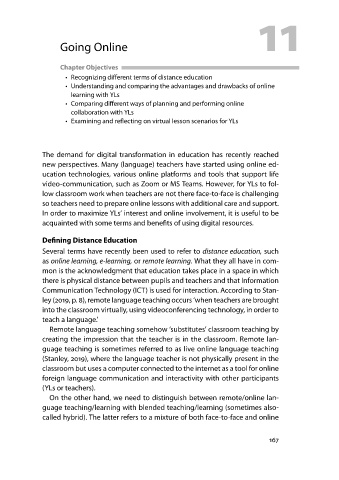Page 167 - Teaching English at Primary Level: From Theory into the Classroom
P. 167
11
Going Online
Chapter Objectives
• Recognizing different terms of distance education
• Understanding and comparing the advantages and drawbacks of online
learning with YLs
• Comparing different ways of planning and performing online
collaboration with YLs
• Examining and reflecting on virtual lesson scenarios for YLs
The demand for digital transformation in education has recently reached
new perspectives. Many (language) teachers have started using online ed-
ucation technologies, various online platforms and tools that support life
video-communication, such as Zoom or MS Teams. However, for YLs to fol-
low classroom work when teachers are not there face-to-face is challenging
so teachers need to prepare online lessons with additional care and support.
In order to maximize YLs’ interest and online involvement, it is useful to be
acquainted with some terms and benefits of using digital resources.
Defining Distance Education
Several terms have recently been used to refer to distance education, such
as online learning, e-learning, or remote learning. What they all have in com-
mon is the acknowledgment that education takes place in a space in which
there is physical distance between pupils and teachers and that Information
Communication Technology (ICT) is used for interaction. According to Stan-
ley (2019, p. 8), remote language teaching occurs ‘when teachers are brought
into the classroom virtually, using videoconferencing technology, in order to
teach a language.’
Remote language teaching somehow ‘substitutes’ classroom teaching by
creating the impression that the teacher is in the classroom. Remote lan-
guage teaching is sometimes referred to as live online language teaching
(Stanley, 2019), where the language teacher is not physically present in the
classroom but uses a computer connected to the internet as a tool for online
foreign language communication and interactivity with other participants
(YLs or teachers).
On the other hand, we need to distinguish between remote/online lan-
guage teaching/learning with blended teaching/learning (sometimes also-
called hybrid). The latter refers to a mixture of both face-to-face and online
167

